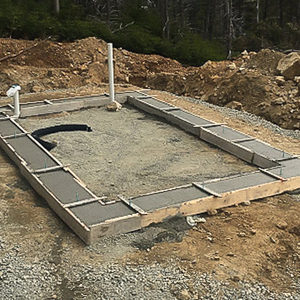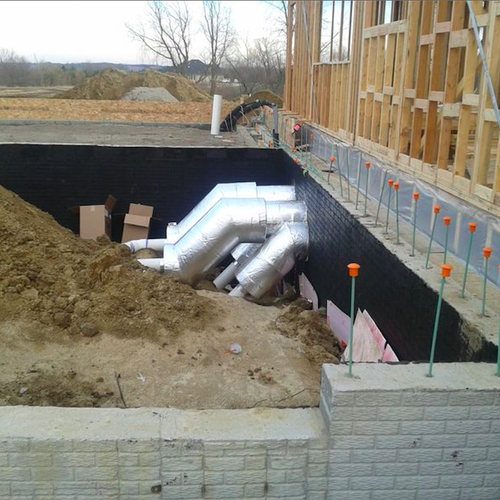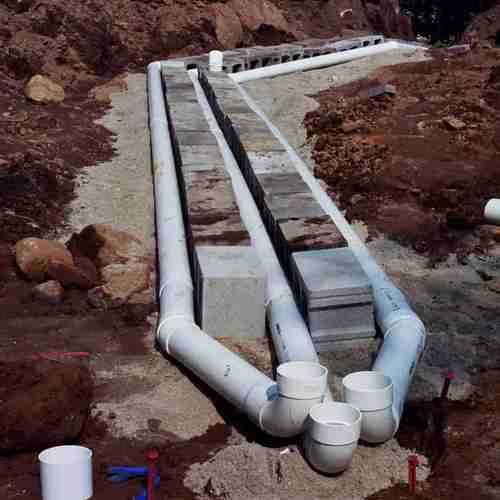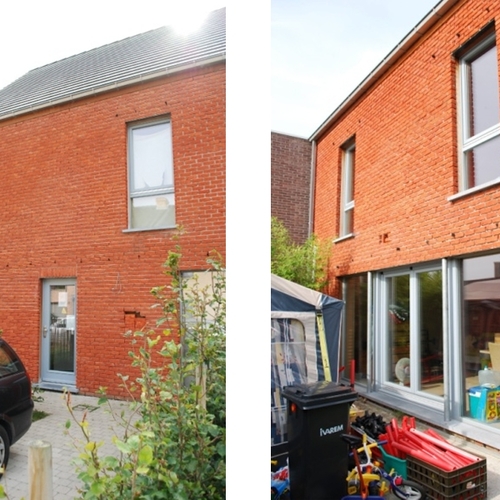
Image Credit: Malcolm Isaacs
An earth tube is a buried ventilation duct. The idea behind burying ventilation ducts — the ducts conveying fresh outdoor air to a building — is that the soil surrounding the ducts will warm the ventilation air during the winter and cool the ventilation air during the summer.
Earth tubes can work, as long as:
- the duct is installed in a climate with useful soil temperatures,
- the duct has a large enough diameter,
- the duct is long enough,
- the duct is buried deep enough,
- the duct is installed in a way that minimizes potential condensation problems,
- the duct is able to exclude radon.
That said, earth tubes are expensive to install, so they are rarely a cost-effective way to condition ventilation air.
Poorly designed earth tube systems are probably more common than well designed earth tube systems, which is why many earth tubes are eventually capped off and abandoned. If you are considering installing an earth tube, it’s worth learning about what works and what doesn’t.
Get the details right to avoid mold
Earth tubes have a mixed reputation, and it’s easy to find published reports of successes as well as failures. Full disclosure: I’m not a fan of earth tubes. If I wanted, I suppose that I could cherry-pick scary stories from among published anecdotes, but that would be unfair. If you want to install an earth tube, and you do your homework before installing your system, there’s no reason to think that ventilation air delivered by your earth tubes will be damp or mold-infested. Some earth tube systems work well.
The main problem with earth tubes is that even when builders install a well-designed system, the energy savings are so low that it’s hard to justify the high installation cost.
Successful systems
Earth tube…
Weekly Newsletter
Get building science and energy efficiency advice, plus special offers, in your inbox.

This article is only available to GBA Prime Members
Sign up for a free trial and get instant access to this article as well as GBA’s complete library of premium articles and construction details.
Start Free TrialAlready a member? Log in















6 Comments
Overly pessimistic
Surely you could send a child with a brush into a small diameter pipe than four feet?
Response to Malcolm Taylor
Malcolm,
You're right. I forgot about all the times I crawled into culverts when I was a kid. It was fun.
Response to Martin and Malcolm
It's important to plan ahead for cleaning earth tubes. If you put a rope in during installation, all you need to do is find a child who's a tight fit, tie the rope to his feet and pull.
This is by far my favorite comment! Thank you Stephen, you made my day! :)
earth air tubes- JM
Nice article Martin. I'm on year six with my earth air tubes... with no cleaning. I can't scientifically say there has been no problems- but I can say that anecdotally.... I have had no problems. I'll have to find someone with a scope to inspect them I guess. But everything seems to be working fine. And my tube cost was the cheap one. At the beginning of the season is when you have the highest 'capacity'. Moving from winter to summer... ground is still cold... and you are using it to 'cool incoming air'. Summer to winter- ground is still hot and you are using it to 'heat incoming air'. There is roughly a 16 degree temperature swing from beginning to end of season. Could be more or less- depending on tube depth. At $1800- I would still say it is worth it. It eliminates the cost of preheat on a H/ERV... both the up front equipment cost, and the energy use cost over the life. Another interesting point- all cost comparison is based on indoor set temperatures... 68-72 F... If your goal was instead to 'survive' - they would have much higher value as passive means to keep your home from freezing. - Jason Morosko
Martin highlighted this great article in a June 2020 mailing. I figure he probably did it bec. GBA is a treasure trove and some of us do need a tour guide sometimes. The article is of interest to me because some professionals (though not others) believe that I ought to dig a costly French drain and I haven't ruled it out. It's a hill and the footings are really deep. A neighbor told me his drain involved trenches as deep as 16+ feet. I suppose mine might be more like 8 feet, hard to tell. Mainly all you'll see is some trickles after a rain. But digging is still a maybe, because hydrostatic pressure from the hill above can affect IAQ or so my nose says sometimes. (That's also reason enough for me to be cautious about crawlspace-floor vapor barriers.)
I would hope to do some cost-benefit analysis on earth tubes for myself. Though it's a shame the building industry seems to have nobody available who can help me with that for any price. Generic payback numbers on anything at all are never of interest to me. First of all, those generic numbers always omit to count the budget I already have for renovating a resilient antique. In this case that's the budget for comfort and IAQ. Also generic payback numbers always seem to be about new construction. And they seem to assume that a homeowner cares a lot about beyond-compliance energy efficiency measures but does not care about beyond-compliance comfort and IAQ. I could point to others who are far more picky and have far greater budgets than I, especially in California's climate zone 3C.
So with that long explanation, this is a lot of really interesting material to study and it's likely to keep stimulating my curiosity. As for getting anyone competent to do the work that seems next to hopeless in 2020-2021. Maybe this is some project I take on when I retire. From time to time I end up having to tell people, well I am an engineer, and even though my name was the last one on the list, I am qualified . Thanks again for an outstanding 5-star article Martin, I am a fan.
Log in or become a member to post a comment.
Sign up Log in